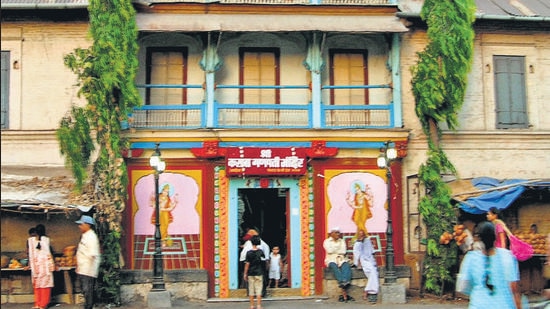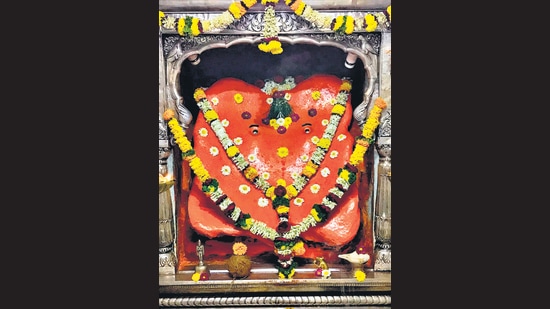Sutradhara’s tales: Aniconic form assumes pride of place on Pune’s altar of faith
The story of Kasba Ganpati starts with an allegory, in which Thakaar (one of the principal families of Pune in the 16th century) dreamed that the Lord is under the Shami tree alongside the Ambil Odha stream which originally flowed roughly along the present Bajirao road
Did you know, the “numero uno” house in Pune belongs to a deity and not a person?

The deity is the village guardian deity (now city guardian) of Pune, the Kasba Ganpati in Kasba peth. The inhabitants of most Indian villages and towns which have origins in a historical past practised establishing a guardian spirit or “sthan devata”. These tutelary deities act as patron, protector and guardian of the settlement and its inhabitants, and are revered by locals.
The story of Kasba Ganpati starts with an allegory, in which Thakaar (one of the principal families of Pune in the 16th century) dreamed that the Lord is under the Shami tree alongside the Ambil Odha stream which originally flowed roughly along the present Bajirao road. Being a staunch devotee of Ganesha, this Brahmin searched the stream and rescued the anionic slab of stone which represented lord Ganesha.
This aniconic form (tandala) of Ganesha was then established in a stone sanctum and worshipped started around the 15th-16th century CE.
Traditionally, the management of the temple and priestly functions are looked after by the Thakaar family itself, even today.

The earliest documentary reference to this temple is from 1613-14, and 1618. It was a part of the Ahmednangar Nizamshah territory. Haibatkhan and Malik Amber, the Nizamshahi ministers had granted Inam to Vinayak Bhat Thakaar for protection and “varshasan”, annual expenses, of the deity and temple. Pune was destroyed and abandoned after Rayarao’s attack under Murar Jagdeo’s orders in 1631 and the temple seems to have suffered a great loss. The idol, till 1637 CE, barely managed to survive in a modest temple of unbaked bricks.
Revival and re-settlement of the settlement of Pune was undertaken by renovating and restoring the gram devata - Kasba Ganesha - before laying the foundations of the Lal Mahal - the residence of Rajmata Jijabai and Chhatrapati Shivaji Maharaj.
They made a donation in the form of a Sanad (decree) on March 19, 1647, for this purpose to Vinayak Bhat Thakaar. The Sanad mentions the Kasba Ganpati as “Jayati Gajaanan”.
There exists an older idol of Ganesha on the same premise which was in the private worship of the Thakaar family. It was buried in the niche of foundation of a house around the present temple at distance of 50ft from the sanctum.
The present main idol is around 3.5-feet tall and has two diamonds decorating the eyes and a ruby in the navel of the aniconic form.
The temple today is enclosed in a high-walled prakara with a wood-carved nagarkhana (drum house) acting as the entrance facade.
The plan of temple has an octagonal sanctum or garbhagriha with a small rectangular pillared sabhamandapa in stone masonry. This is the oldest part of the temple. The smaller mandapa have peculiar pillars which retain the later yadava characteristic mouldings and inverted serpent capitals. The sanctum is the oldest part of the temple along with stone mandapa and houses minor modern sculptures of other deities, including nagas.
It is followed by an open wooden two-storeyed mandapa with a balcony on the first floor which was typically reserved for women. Gajananrao Sadashiv Dikshit, a Dakkhani Sardar, added this typical Peshwa style sabhamandapa adorned with cusped arches, cypruss columns and banana flower motifs.
The Lakde family added a pavement all around the temple and dharmshala which serves as a rest-house and place for dining and gatherings.
The shikhara of the temple is done in typical Peshwa style (brick stucco) though the original painted motifs are lost. However, the changes over time, have made it difficult to distinguish other older structures.
In 1877, a public cistern was built in the temple yard which was later covered. The brick prakara was built in later times along with the ornate wooden façade gateway at the entrance.
During the Peshwa period, the temple enjoyed a monthly allowance of Rs10 from the Parvati temple revenues, and the expenses of the yearly celebration of the Ganpati festival on Ganesh Chaturthi were also paid from the Parvati grant.
The public form of the Ganeshotsav celebration of Kasba Ganpati was started in 1896. Even today, it is the first to receive an invitation of marriage or any important function in the family life of Punekars.
Various political party representatives flock to the temple during elections to kick-start their campaigns.
The temple is abuzz with students seeking blessings during exam season. Throughout the day, it has a steady flow of devotees.
From the Yadava period herostones depicting Ganesha as the tutelary deity, to the strong Ganpatya tradition in Chinchwad founded by Moraya Gosavi and his disciples, the history of Ganesha worship goes way back in time for Pune.
No wonder, the Bhat Peshwa family too extended their patronage and became devout Ganesha followers when they made Pune their residence. Archives published by Dadasaheb Onkar inform us of a long tradition of Ganpatya (followers of Ganesha sect), which include Nanasahib Peshwa and Madhavrao Peshwa, the then prime ministers of the Maratha Empire.
Kasba Ganpati is the most venerated deity for Punekars. It is called “Manacha Pahila Ganpati” (one which deserves the first respect). It, thus, has the honour of leading the Ganpati procession during the Pune Ganeshutsav every year.
The Kasba Ganpati temple campus is of a modest stature, but has played significant role in the lives of Punekars. Pune suffered great crises over the centuries - droughts, political upheavals, attacks, epidemics and floods. Kasba Ganpati has stood with Punekars and boosted their morale through the high and lows of history.
In an ever-expanding Pune city, things have not changed. The core of the city has been providing positivity in the face of adversity through the cultural identity of a collective space; symbolised by Kasba Ganpati.
It is a perfect representation of a stable divine force existing on ancient grounds, for believers, yet an unassuming form in today’s changing, glittery world.



